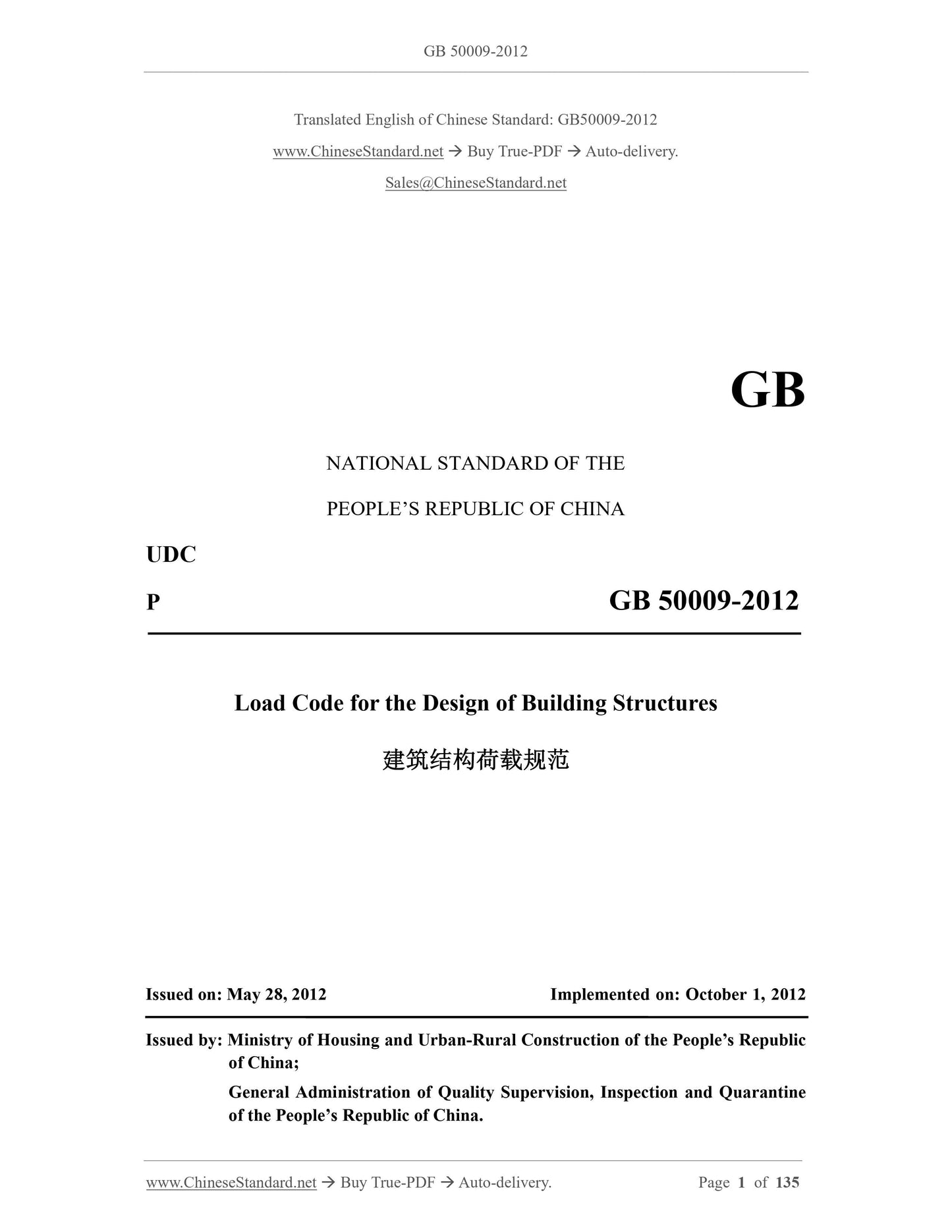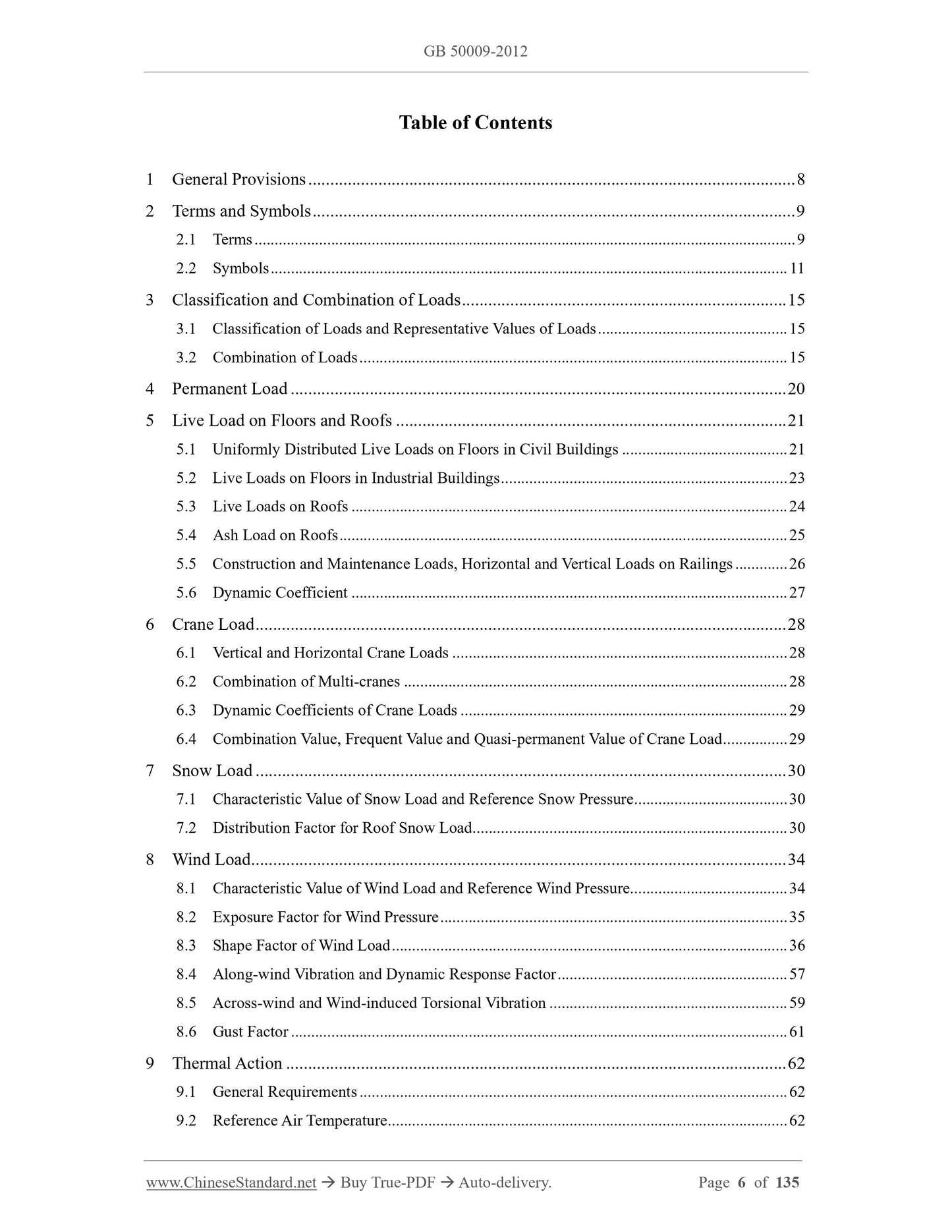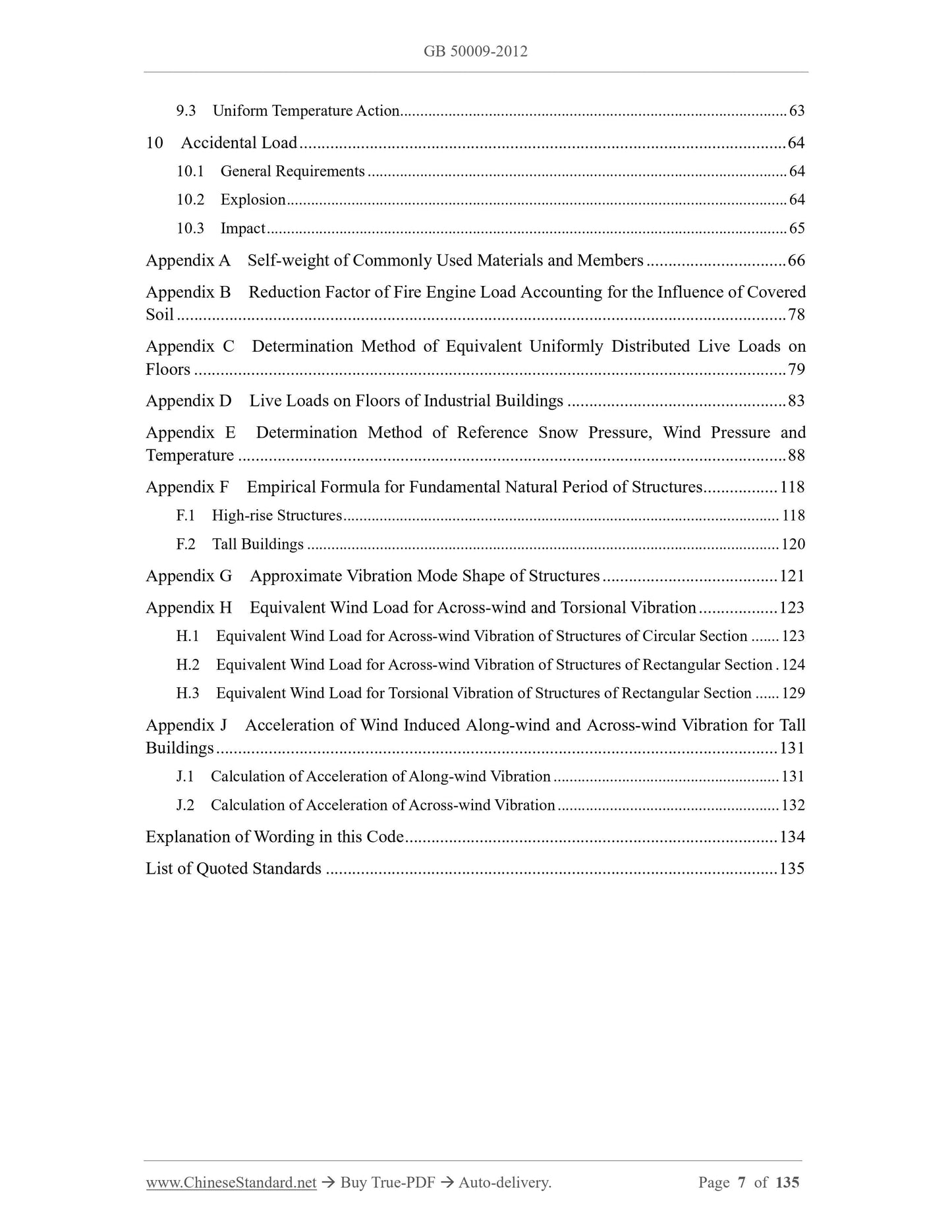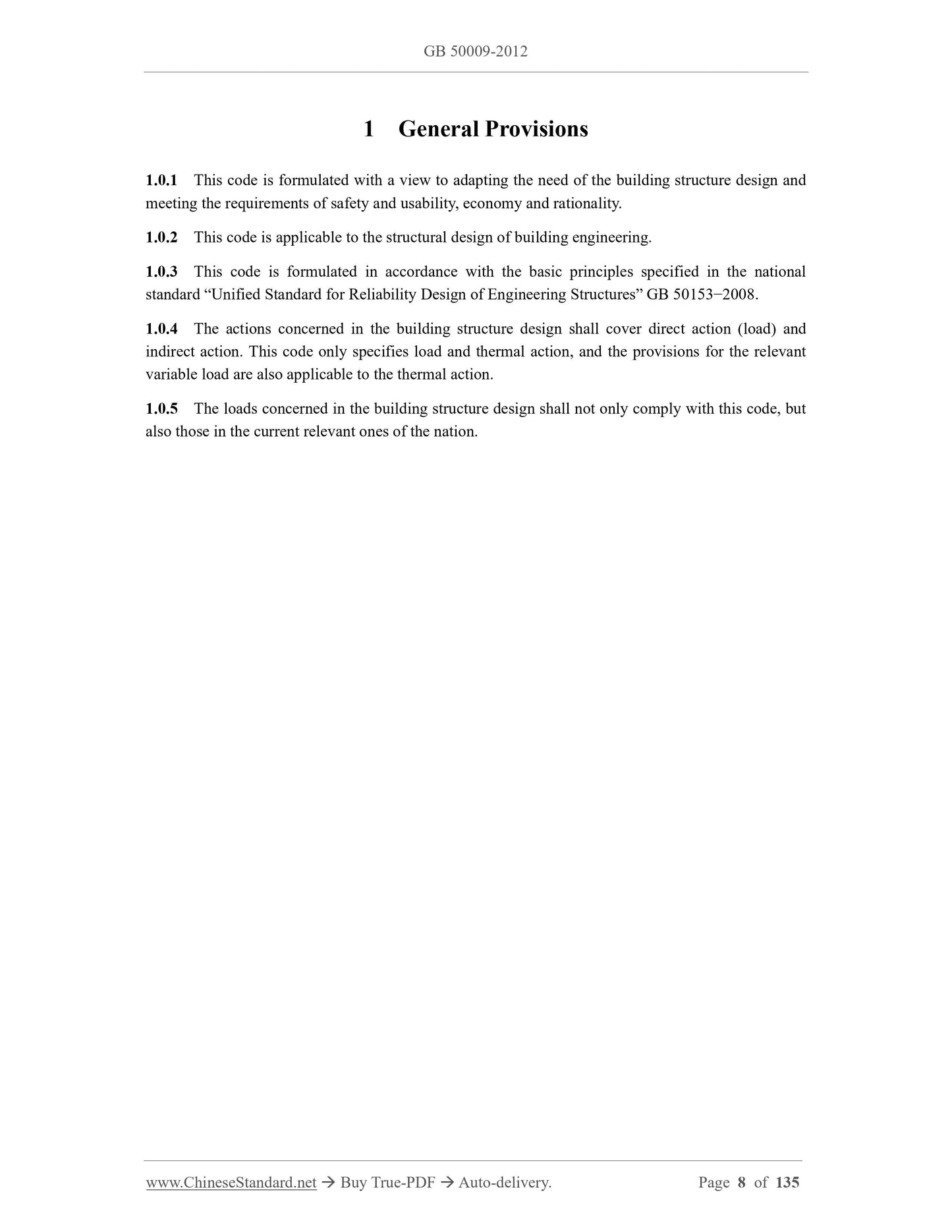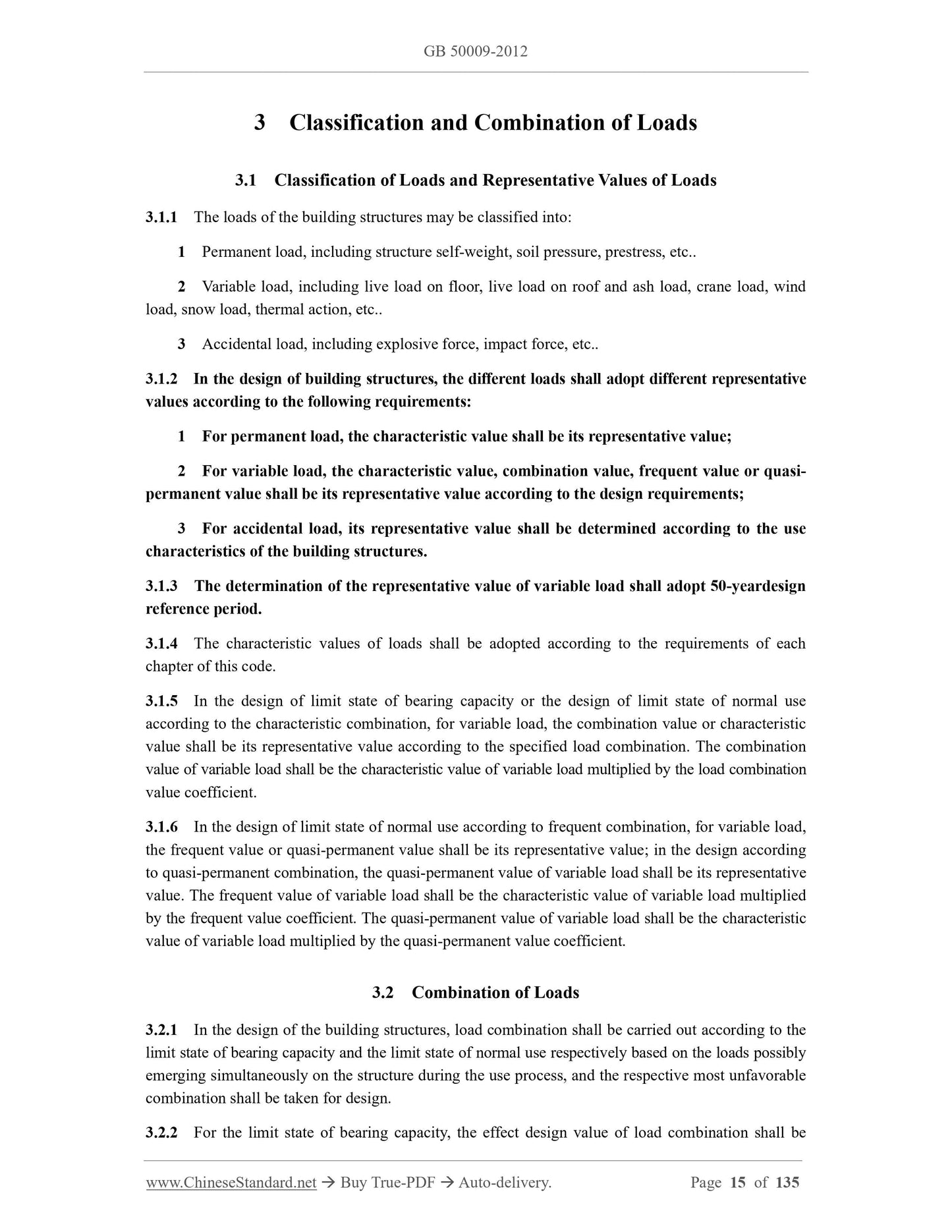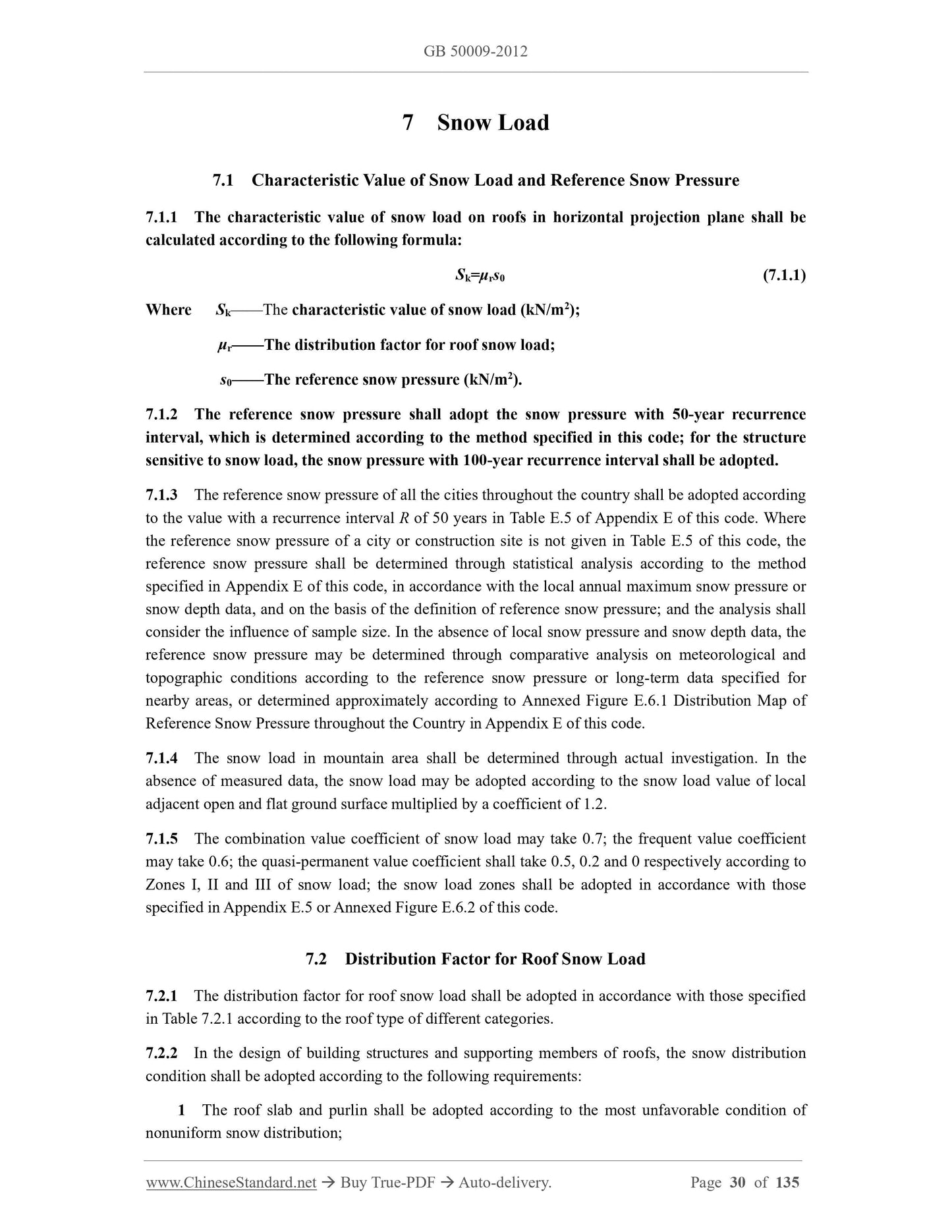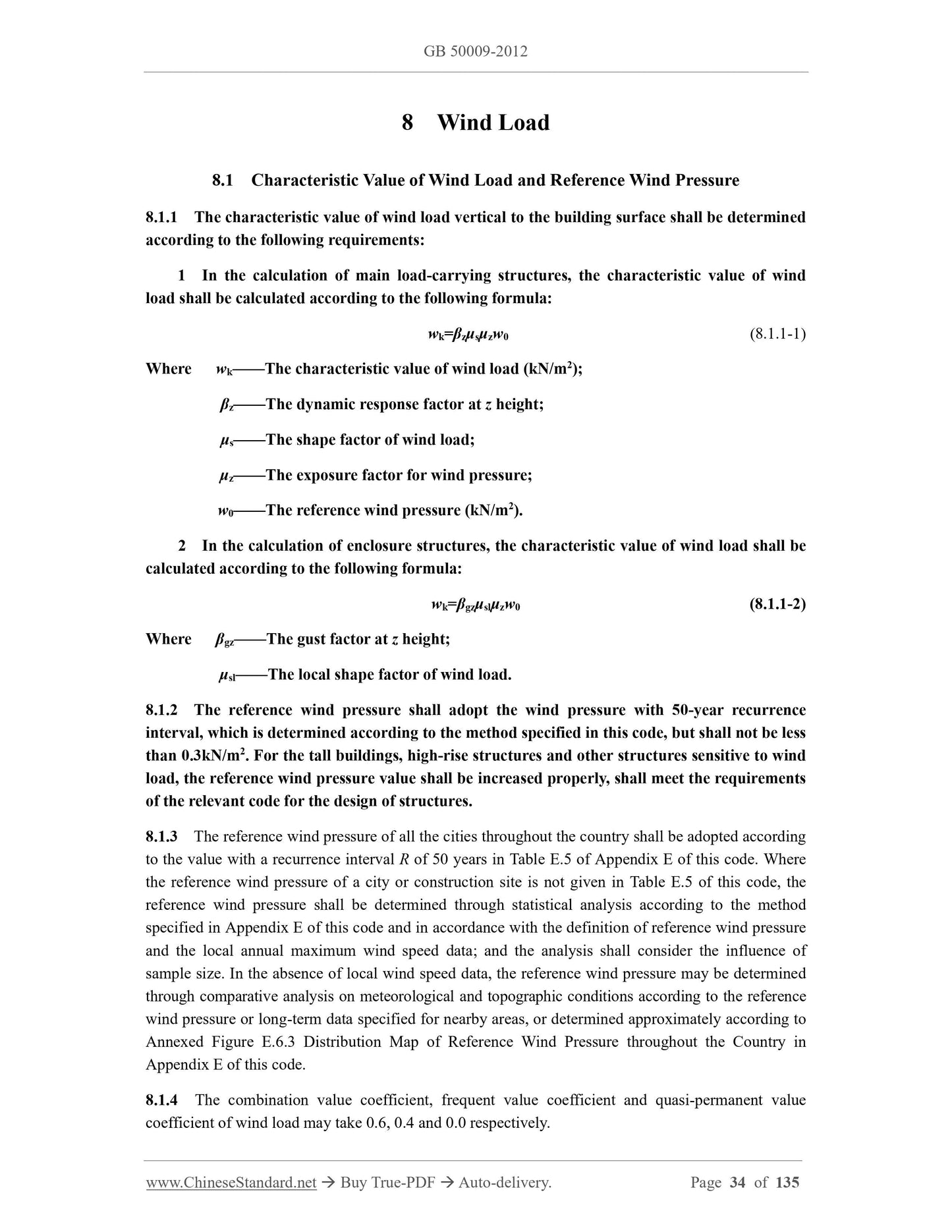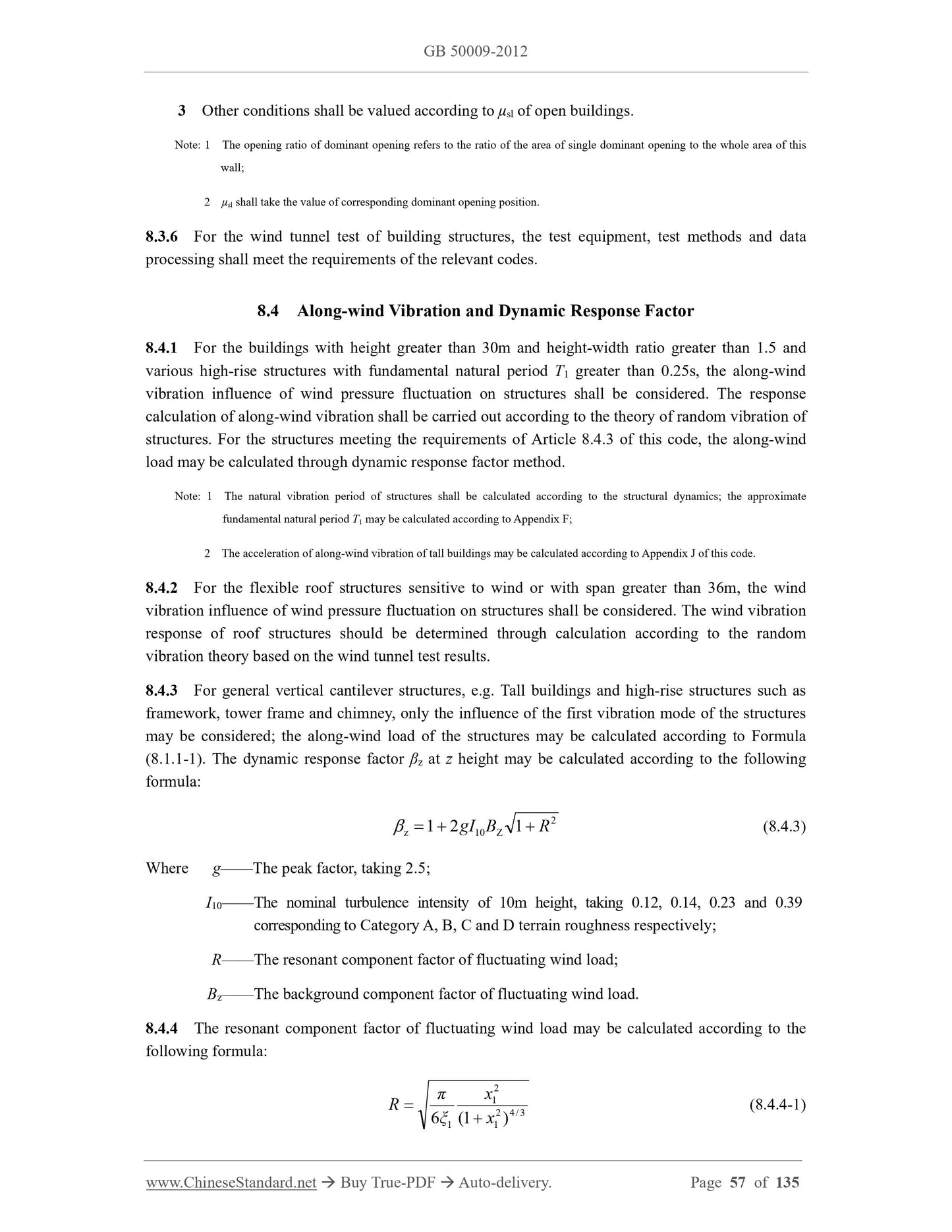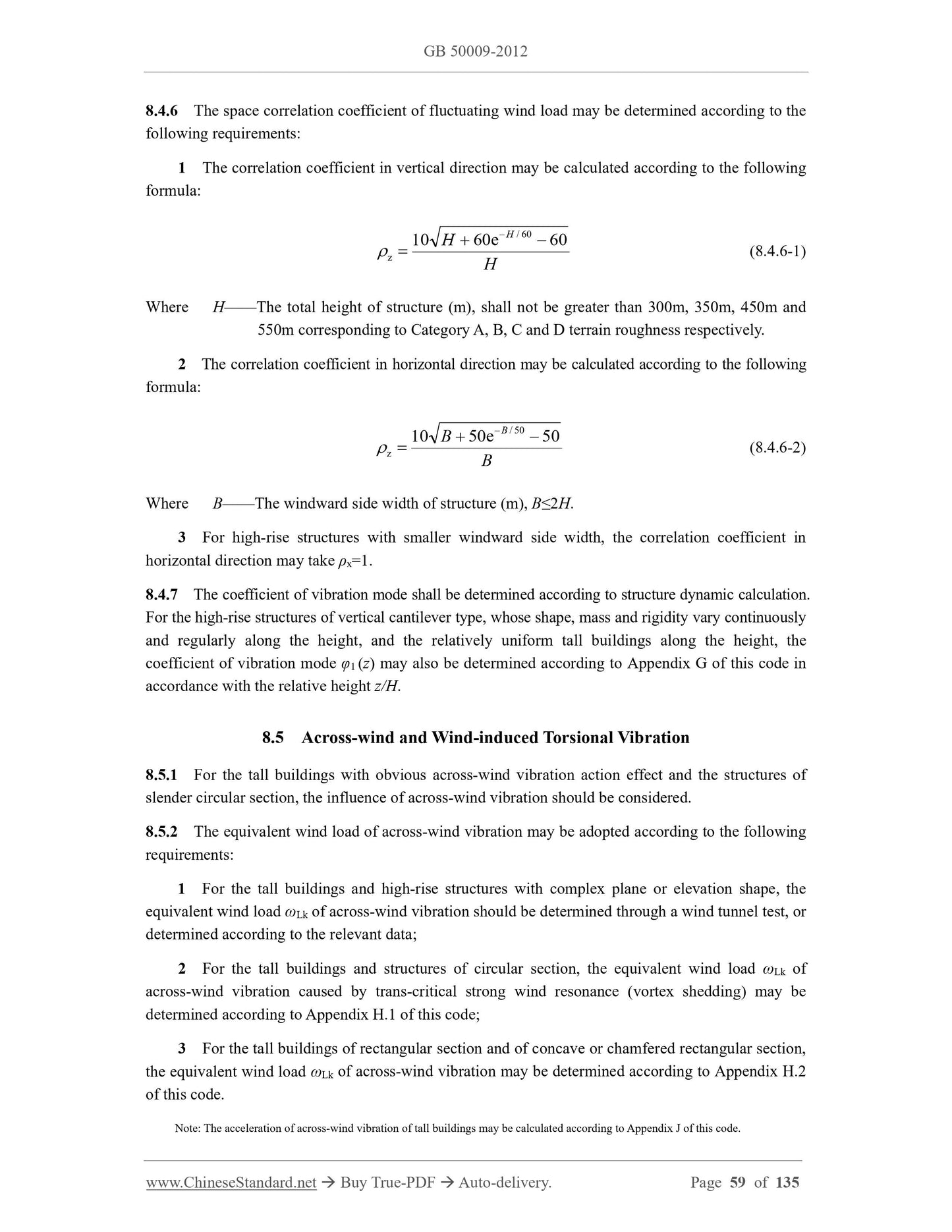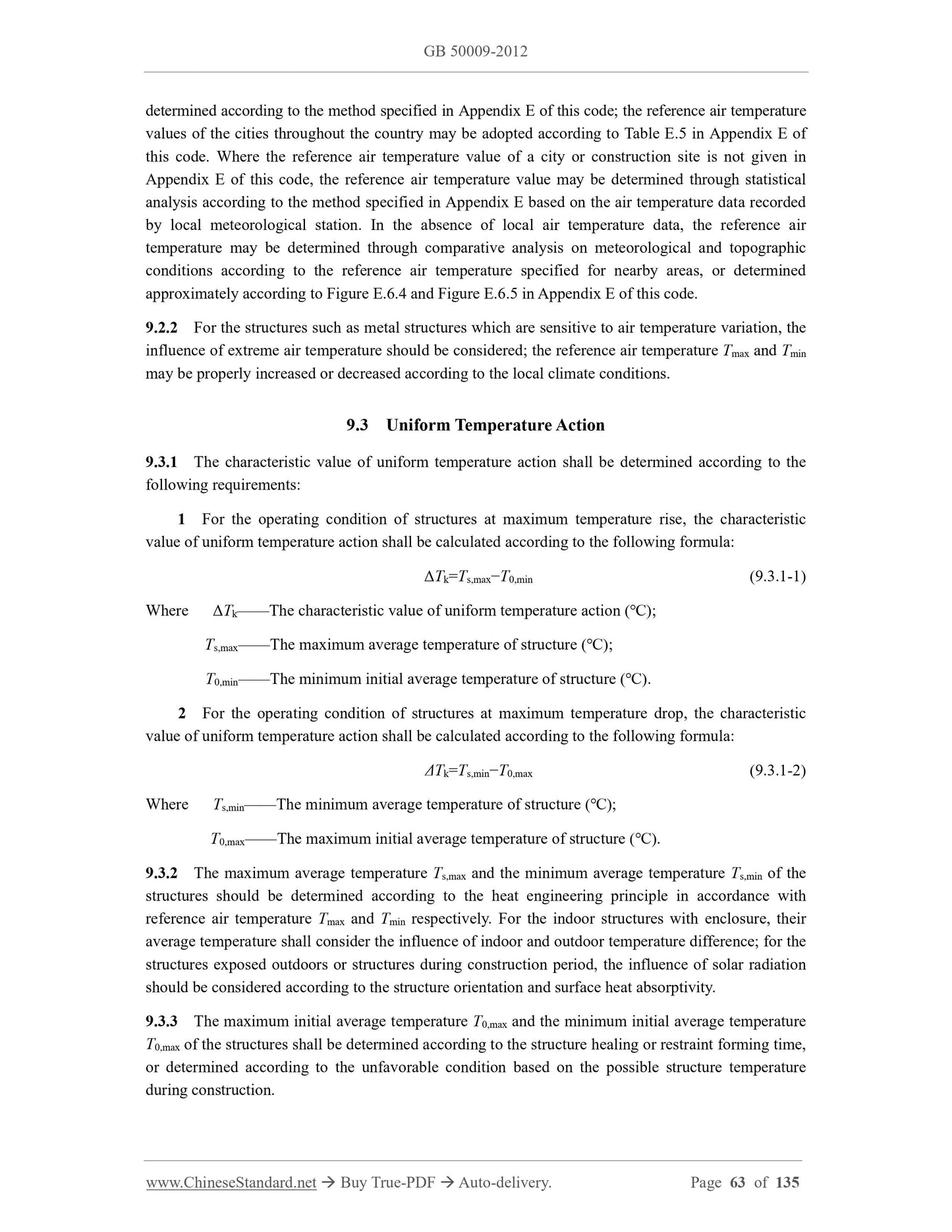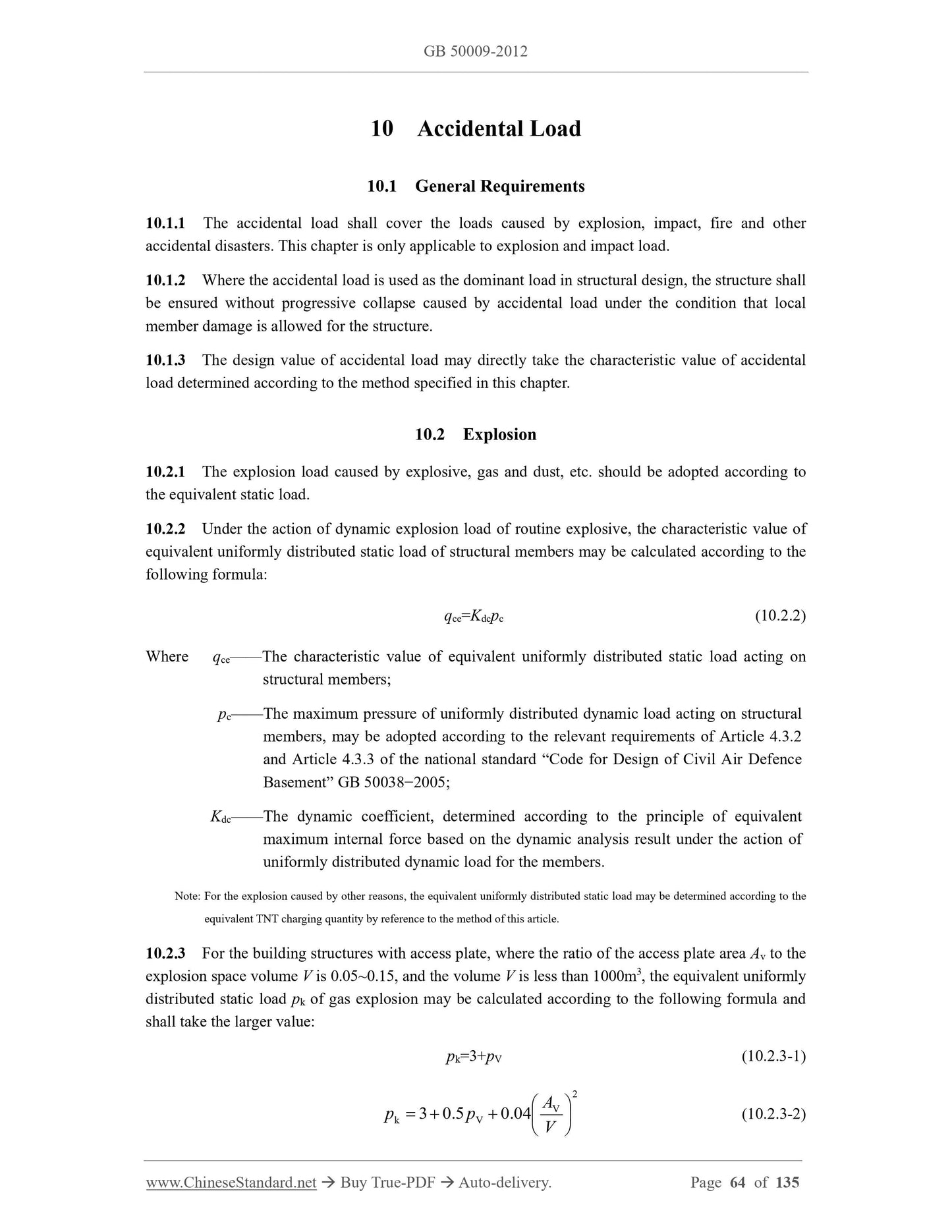1
/
of
12
www.ChineseStandard.us -- Field Test Asia Pte. Ltd.
GB 50009-2012 English PDF
GB 50009-2012 English PDF
Regular price
$125.00
Regular price
Sale price
$125.00
Unit price
/
per
Shipping calculated at checkout.
Couldn't load pickup availability
GB 50009-2012: Load code for the design of building structures
Delivery: 9 seconds. Download (& Email) true-PDF + Invoice.
Get Quotation: Click GB 50009-2012 (Self-service in 1-minute)
Historical versions (Master-website): GB 50009-2012
Preview True-PDF (Reload/Scroll-down if blank)
GB 50009-2012
GB
NATIONAL STANDARD OF THE
PEOPLE’S REPUBLIC OF CHINA
UDC
P GB 50009-2012
Load Code for the Design of Building Structures
ISSUED ON: MAY 28, 2012
IMPLEMENTED ON: OCTOBER 1, 2012
Issued by: Ministry of Housing and Urban-Rural Construction of the People’s Republic
of China;
General Administration of Quality Supervision, Inspection and Quarantine
of the People’s Republic of China.
Table of Contents
1 General Provisions ... 8
2 Terms and Symbols ... 9
2.1 Terms ... 9
2.2 Symbols ... 11
3 Classification and Combination of Loads ... 15
3.1 Classification of Loads and Representative Values of Loads ... 15
3.2 Combination of Loads ... 15
4 Permanent Load ... 20
5 Live Load on Floors and Roofs ... 21
5.1 Uniformly Distributed Live Loads on Floors in Civil Buildings ... 21
5.2 Live Loads on Floors in Industrial Buildings ... 23
5.3 Live Loads on Roofs ... 24
5.4 Ash Load on Roofs ... 25
5.5 Construction and Maintenance Loads, Horizontal and Vertical Loads on Railings ... 26
5.6 Dynamic Coefficient ... 27
6 Crane Load ... 28
6.1 Vertical and Horizontal Crane Loads ... 28
6.2 Combination of Multi-cranes ... 28
6.3 Dynamic Coefficients of Crane Loads ... 29
6.4 Combination Value, Frequent Value and Quasi-permanent Value of Crane Load ... 29
7 Snow Load ... 30
7.1 Characteristic Value of Snow Load and Reference Snow Pressure ... 30
7.2 Distribution Factor for Roof Snow Load ... 30
8 Wind Load ... 34
8.1 Characteristic Value of Wind Load and Reference Wind Pressure ... 34
8.2 Exposure Factor for Wind Pressure ... 35
8.3 Shape Factor of Wind Load ... 36
8.4 Along-wind Vibration and Dynamic Response Factor ... 57
8.5 Across-wind and Wind-induced Torsional Vibration ... 59
8.6 Gust Factor ... 61
9 Thermal Action ... 62
9.1 General Requirements ... 62
9.2 Reference Air Temperature ... 62
9.3 Uniform Temperature Action... 63
10 Accidental Load ... 64
10.1 General Requirements ... 64
10.2 Explosion ... 64
10.3 Impact ... 65
Appendix A Self-weight of Commonly Used Materials and Members ... 66
Appendix B Reduction Factor of Fire Engine Load Accounting for the Influence of Covered
Soil ... 78
Appendix C Determination Method of Equivalent Uniformly Distributed Live Loads on
Floors ... 79
Appendix D Live Loads on Floors of Industrial Buildings ... 83
Appendix E Determination Method of Reference Snow Pressure, Wind Pressure and
Temperature ... 88
Appendix F Empirical Formula for Fundamental Natural Period of Structures ... 118
F.1 High-rise Structures ... 118
F.2 Tall Buildings ... 120
Appendix G Approximate Vibration Mode Shape of Structures ... 121
Appendix H Equivalent Wind Load for Across-wind and Torsional Vibration ... 123
H.1 Equivalent Wind Load for Across-wind Vibration of Structures of Circular Section ... 123
H.2 Equivalent Wind Load for Across-wind Vibration of Structures of Rectangular Section . 124
H.3 Equivalent Wind Load for Torsional Vibration of Structures of Rectangular Section ... 129
Appendix J Acceleration of Wind Induced Along-wind and Across-wind Vibration for Tall
Buildings ... 131
J.1 Calculation of Acceleration of Along-wind Vibration ... 131
J.2 Calculation of Acceleration of Across-wind Vibration ... 132
Explanation of Wording in this Code ... 134
List of Quoted Standards ... 135
1 General Provisions
1.0.1 This code is formulated with a view to adapting the need of the building structure design and
meeting the requirements of safety and usability, economy and rationality.
1.0.2 This code is applicable to the structural design of building engineering.
1.0.3 This code is formulated in accordance with the basic principles specified in the national
standard “Unified Standard for Reliability Design of Engineering Structures” GB 50153−2008.
1.0.4 The actions concerned in the building structure design shall cover direct action (load) and
indirect action. This code only specifies load and thermal action, and the provisions for the relevant
variable load are also applicable to the thermal action.
1.0.5 The loads concerned in the building structure design shall not only comply with this code, but
also those in the current relevant ones of the nation.
3 Classification and Combination of Loads
3.1 Classification of Loads and Representative Values of Loads
3.1.1 The loads of the building structures may be classified into:
1 Permanent load, including structure self-weight, soil pressure, prestress, etc..
2 Variable load, including live load on floor, live load on roof and ash load, crane load, wind
load, snow load, thermal action, etc..
3 Accidental load, including explosive force, impact force, etc..
3.1.2 In the design of building structures, the different loads shall adopt different representative
values according to the following requirements:
1 For permanent load, the characteristic value shall be its representative value;
2 For variable load, the characteristic value, combination value, frequent value or quasi-
permanent value shall be its representative value according to the design requirements;
3 For accidental load, its representative value shall be determined according to the use
characteristics of the building structures.
3.1.3 The determination of the representative value of variable load shall adopt 50-yeardesign
reference period.
3.1.4 The characteristic values of loads shall be adopted according to the requirements of each
chapter of this code.
3.1.5 In the design of limit state of bearing capacity or the design of limit state of normal use
according to the characteristic combination, for variable load, the combination value or characteristic
value shall be its representative value according to the specified load combination. The combination
value of variable load shall be the characteristic value of variable load multiplied by the load combination
value coefficient.
3.1.6 In the design of limit state of normal use according to frequent combination, for variable load,
the frequent value or quasi-permanent value shall be its representative value; in the design according
to quasi-permanent combination, the quasi-permanent value of variable load shall be its representative
value. The frequent value of variable load shall be the characteristic value of variable load multiplied
by the frequent value coefficient. The quasi-permanent value of variable load shall be the characteristic
value of variable load multiplied by the quasi-permanent value coefficient.
3.2 Combination of Loads
3.2.1 In the design of the building structures, load combination shall be carried out according to the
limit state of bearing capacity and the limit state of normal use respectively based on the loads possibly
emerging simultaneously on the structure during the use process, and the respective most unfavorable
combination shall be taken for design.
3.2.2 For the limit state of bearing capacity, the effect design value of load combination shall be
7 Snow Load
7.1 Characteristic Value of Snow Load and Reference Snow Pressure
7.1.1 The characteristic value of snow load on roofs in horizontal projection plane shall be
calculated according to the following formula:
Sk=μrs0 (7.1.1)
Where Sk——The characteristic value of snow load (kN/m2);
μr——The distribution factor for roof snow load;
s0——The reference snow pressure (kN/m2).
7.1.2 The reference snow pressure shall adopt the snow pressure with 50-year recurrence
interval, which is determined according to the method specified in this code; for the structure
sensitive to snow load, the snow pressure with 100-year recurrence interval shall be adopted.
7.1.3 The reference snow pressure of all the cities throughout the country shall be adopted according
to the value with a recurrence interval R of 50 years in Table E.5 of Appendix E of this code. Where
the reference snow pressure of a city or construction site is not given in Table E.5 of this code, the
reference snow pressure shall be determined through statistical analysis according to the method
specified in Appendix E of this code, in accordance with the local annual maximum snow pressure or
snow depth data, and on the basis of the definition of reference snow pressure; and the analysis shall
consider the influence of sample size. In the absence of local snow pressure and snow depth data, the
reference snow pressure may be determined through comparative analysis on meteorological and
topographic conditions according to the reference snow pressure or long-term data specified for
nearby areas, or determined approximately according to Annexed Figure E.6.1 Distribution Map of
Reference Snow Pressure throughout the Country in Appendix E of this code.
7.1.4 The snow load in mountain area shall be determined through actual investigation. In the
absence of measured data, the snow load may be adopted according to the snow load value of local
adjacent open and flat ground surface multiplied by a coefficient of 1.2.
7.1.5 The combination value coefficient of snow load may take 0.7; the frequent value coefficient
may take 0.6; the quasi-permanent value coefficient shall take 0.5, 0.2 and 0 respectively according to
Zones I, II and III of snow load; the snow load zones shall be adopted in accordance with those
specified in Appendix E.5 or Annexed Figure E.6.2 of this code.
7.2 Distribution Factor for Roof Snow Load
7.2.1 The distribution factor for roof snow load shall be adopted in accordance with those specified
in Table 7.2.1 according to the roof type of different categories.
7.2.2 In the design of building structures and supporting members of roofs, the snow distribution
condition shall be adopted according to the following requirements:
1 The roof slab and purlin shall be adopted according to the most unfavorable condition of
nonuniform snow distribution;
8 Wind Load
8.1 Characteristic Value of Wind Load and Reference Wind Pressure
8.1.1 The characteristic value of wind load vertical to the building surface shall be determined
according to the following requirements:
1 In the calculation of main load-carrying structures, the characteristic value of wind
load shall be calculated according to the following formula:
wk=βzμsμzw0 (8.1.1-1)
Where wk——The characteristic value of wind load (kN/m2);
βz——The dynamic response factor at z height;
μs——The shape factor of wind load;
μz——The exposure factor for wind pressure;
w0——The reference wind pressure (kN/m2).
2 In the calculation of enclosure structures, the characteristic value of wind load shall be
calculated according to the following formula:
wk=βgzμslμzw0 (8.1.1-2)
Where βgz——The gust factor at z height;
μsl——The local shape factor of wind load.
8.1.2 The reference wind pressure shall adopt the wind pressure with 50-year recurrence
interval, which is determined according to the method specified in this code, but shall not be less
than 0.3kN/m2. For the tall buildings, high-rise structures and other structures sensitive to wind
load, the reference wind pressure value shall be increased properly, shall meet the requirements
of the relevant code for the design of structures.
8.1.3 The reference wind pressure of all the cities throughout the country shall be adopted according
to the value with a recurrence interval R of 50 years in Table E.5 of Appendix E of this code. Where
the reference wind pressure of a city or construction site is not given in Table E.5 of this code, the
reference wind pressure shall be determined through statistical analysis according to the method
specified in Appendix E of this code and in accordance with the definition of reference wind pressure
and the local annual maximum wind speed data; and the analysis shall consider the influence of
sample size. In the absence of local wind speed data, the reference wind pressure may be determined
through comparative analysis on meteorological and topographic conditions according to the reference
wind pressure or long-term data specified for nearby areas, or determined approximately according to
Annexed Figure E.6.3 Distribution Map of Reference Wind Pressure throughout the Country in
Appendix E of this code.
8.1.4 The combination value coefficient, frequent value coefficient and quasi-permanent value
coefficient of wind load may take 0.6, 0.4 and 0.0 respectively.
3 Other conditions shall be valued according to μsl of open buildings.
Note: 1 The opening ratio of dominant opening refers to the ratio of the area of single dominant opening to the whole area of this
wall;
2 μsl shall take the value of corresponding dominant opening position.
8.3.6 For the wind tunnel test of building structures, the test equipment, test methods and data
processing shall meet the requirements of the relevant codes.
8.4 Along-wind Vibration and Dynamic Response Factor
8.4.1 For the buildings with height greater than 30m and height-width ratio greater than 1.5 and
various high-rise structures with fundamental natural period T1 greater than 0.25s, the along-wind
vibration influence of wind pressure fluctuation on structures shall be considered. The response
calculation of along-wind vibration shall be carried out according to the theory of random vibration of
structures. For the structures meeting the requirements of Article 8.4.3 of this code, the along-wind
load may be calculated through dynamic response factor method.
Note: 1 The natural vibration period of structures shall be calculated according to the structural dynamics; the approximate
fundamental natural period T1 may be calculated according to Appendix F;
2 The acceleration of along-wind vibration of tall buildings may be calculated according to Appendix J of this code.
8.4.2 For the flexible roof structures sensitive to wind or with span greater than 36m, the wind
vibration influence of wind pressure fluctuation on structures shall be considered. The wind vibration
response of roof structures should be determined through calculation according to the random
vibration theory based on the wind tunnel test results.
8.4.3 For general vertical cantilever structur...
Delivery: 9 seconds. Download (& Email) true-PDF + Invoice.
Get Quotation: Click GB 50009-2012 (Self-service in 1-minute)
Historical versions (Master-website): GB 50009-2012
Preview True-PDF (Reload/Scroll-down if blank)
GB 50009-2012
GB
NATIONAL STANDARD OF THE
PEOPLE’S REPUBLIC OF CHINA
UDC
P GB 50009-2012
Load Code for the Design of Building Structures
ISSUED ON: MAY 28, 2012
IMPLEMENTED ON: OCTOBER 1, 2012
Issued by: Ministry of Housing and Urban-Rural Construction of the People’s Republic
of China;
General Administration of Quality Supervision, Inspection and Quarantine
of the People’s Republic of China.
Table of Contents
1 General Provisions ... 8
2 Terms and Symbols ... 9
2.1 Terms ... 9
2.2 Symbols ... 11
3 Classification and Combination of Loads ... 15
3.1 Classification of Loads and Representative Values of Loads ... 15
3.2 Combination of Loads ... 15
4 Permanent Load ... 20
5 Live Load on Floors and Roofs ... 21
5.1 Uniformly Distributed Live Loads on Floors in Civil Buildings ... 21
5.2 Live Loads on Floors in Industrial Buildings ... 23
5.3 Live Loads on Roofs ... 24
5.4 Ash Load on Roofs ... 25
5.5 Construction and Maintenance Loads, Horizontal and Vertical Loads on Railings ... 26
5.6 Dynamic Coefficient ... 27
6 Crane Load ... 28
6.1 Vertical and Horizontal Crane Loads ... 28
6.2 Combination of Multi-cranes ... 28
6.3 Dynamic Coefficients of Crane Loads ... 29
6.4 Combination Value, Frequent Value and Quasi-permanent Value of Crane Load ... 29
7 Snow Load ... 30
7.1 Characteristic Value of Snow Load and Reference Snow Pressure ... 30
7.2 Distribution Factor for Roof Snow Load ... 30
8 Wind Load ... 34
8.1 Characteristic Value of Wind Load and Reference Wind Pressure ... 34
8.2 Exposure Factor for Wind Pressure ... 35
8.3 Shape Factor of Wind Load ... 36
8.4 Along-wind Vibration and Dynamic Response Factor ... 57
8.5 Across-wind and Wind-induced Torsional Vibration ... 59
8.6 Gust Factor ... 61
9 Thermal Action ... 62
9.1 General Requirements ... 62
9.2 Reference Air Temperature ... 62
9.3 Uniform Temperature Action... 63
10 Accidental Load ... 64
10.1 General Requirements ... 64
10.2 Explosion ... 64
10.3 Impact ... 65
Appendix A Self-weight of Commonly Used Materials and Members ... 66
Appendix B Reduction Factor of Fire Engine Load Accounting for the Influence of Covered
Soil ... 78
Appendix C Determination Method of Equivalent Uniformly Distributed Live Loads on
Floors ... 79
Appendix D Live Loads on Floors of Industrial Buildings ... 83
Appendix E Determination Method of Reference Snow Pressure, Wind Pressure and
Temperature ... 88
Appendix F Empirical Formula for Fundamental Natural Period of Structures ... 118
F.1 High-rise Structures ... 118
F.2 Tall Buildings ... 120
Appendix G Approximate Vibration Mode Shape of Structures ... 121
Appendix H Equivalent Wind Load for Across-wind and Torsional Vibration ... 123
H.1 Equivalent Wind Load for Across-wind Vibration of Structures of Circular Section ... 123
H.2 Equivalent Wind Load for Across-wind Vibration of Structures of Rectangular Section . 124
H.3 Equivalent Wind Load for Torsional Vibration of Structures of Rectangular Section ... 129
Appendix J Acceleration of Wind Induced Along-wind and Across-wind Vibration for Tall
Buildings ... 131
J.1 Calculation of Acceleration of Along-wind Vibration ... 131
J.2 Calculation of Acceleration of Across-wind Vibration ... 132
Explanation of Wording in this Code ... 134
List of Quoted Standards ... 135
1 General Provisions
1.0.1 This code is formulated with a view to adapting the need of the building structure design and
meeting the requirements of safety and usability, economy and rationality.
1.0.2 This code is applicable to the structural design of building engineering.
1.0.3 This code is formulated in accordance with the basic principles specified in the national
standard “Unified Standard for Reliability Design of Engineering Structures” GB 50153−2008.
1.0.4 The actions concerned in the building structure design shall cover direct action (load) and
indirect action. This code only specifies load and thermal action, and the provisions for the relevant
variable load are also applicable to the thermal action.
1.0.5 The loads concerned in the building structure design shall not only comply with this code, but
also those in the current relevant ones of the nation.
3 Classification and Combination of Loads
3.1 Classification of Loads and Representative Values of Loads
3.1.1 The loads of the building structures may be classified into:
1 Permanent load, including structure self-weight, soil pressure, prestress, etc..
2 Variable load, including live load on floor, live load on roof and ash load, crane load, wind
load, snow load, thermal action, etc..
3 Accidental load, including explosive force, impact force, etc..
3.1.2 In the design of building structures, the different loads shall adopt different representative
values according to the following requirements:
1 For permanent load, the characteristic value shall be its representative value;
2 For variable load, the characteristic value, combination value, frequent value or quasi-
permanent value shall be its representative value according to the design requirements;
3 For accidental load, its representative value shall be determined according to the use
characteristics of the building structures.
3.1.3 The determination of the representative value of variable load shall adopt 50-yeardesign
reference period.
3.1.4 The characteristic values of loads shall be adopted according to the requirements of each
chapter of this code.
3.1.5 In the design of limit state of bearing capacity or the design of limit state of normal use
according to the characteristic combination, for variable load, the combination value or characteristic
value shall be its representative value according to the specified load combination. The combination
value of variable load shall be the characteristic value of variable load multiplied by the load combination
value coefficient.
3.1.6 In the design of limit state of normal use according to frequent combination, for variable load,
the frequent value or quasi-permanent value shall be its representative value; in the design according
to quasi-permanent combination, the quasi-permanent value of variable load shall be its representative
value. The frequent value of variable load shall be the characteristic value of variable load multiplied
by the frequent value coefficient. The quasi-permanent value of variable load shall be the characteristic
value of variable load multiplied by the quasi-permanent value coefficient.
3.2 Combination of Loads
3.2.1 In the design of the building structures, load combination shall be carried out according to the
limit state of bearing capacity and the limit state of normal use respectively based on the loads possibly
emerging simultaneously on the structure during the use process, and the respective most unfavorable
combination shall be taken for design.
3.2.2 For the limit state of bearing capacity, the effect design value of load combination shall be
7 Snow Load
7.1 Characteristic Value of Snow Load and Reference Snow Pressure
7.1.1 The characteristic value of snow load on roofs in horizontal projection plane shall be
calculated according to the following formula:
Sk=μrs0 (7.1.1)
Where Sk——The characteristic value of snow load (kN/m2);
μr——The distribution factor for roof snow load;
s0——The reference snow pressure (kN/m2).
7.1.2 The reference snow pressure shall adopt the snow pressure with 50-year recurrence
interval, which is determined according to the method specified in this code; for the structure
sensitive to snow load, the snow pressure with 100-year recurrence interval shall be adopted.
7.1.3 The reference snow pressure of all the cities throughout the country shall be adopted according
to the value with a recurrence interval R of 50 years in Table E.5 of Appendix E of this code. Where
the reference snow pressure of a city or construction site is not given in Table E.5 of this code, the
reference snow pressure shall be determined through statistical analysis according to the method
specified in Appendix E of this code, in accordance with the local annual maximum snow pressure or
snow depth data, and on the basis of the definition of reference snow pressure; and the analysis shall
consider the influence of sample size. In the absence of local snow pressure and snow depth data, the
reference snow pressure may be determined through comparative analysis on meteorological and
topographic conditions according to the reference snow pressure or long-term data specified for
nearby areas, or determined approximately according to Annexed Figure E.6.1 Distribution Map of
Reference Snow Pressure throughout the Country in Appendix E of this code.
7.1.4 The snow load in mountain area shall be determined through actual investigation. In the
absence of measured data, the snow load may be adopted according to the snow load value of local
adjacent open and flat ground surface multiplied by a coefficient of 1.2.
7.1.5 The combination value coefficient of snow load may take 0.7; the frequent value coefficient
may take 0.6; the quasi-permanent value coefficient shall take 0.5, 0.2 and 0 respectively according to
Zones I, II and III of snow load; the snow load zones shall be adopted in accordance with those
specified in Appendix E.5 or Annexed Figure E.6.2 of this code.
7.2 Distribution Factor for Roof Snow Load
7.2.1 The distribution factor for roof snow load shall be adopted in accordance with those specified
in Table 7.2.1 according to the roof type of different categories.
7.2.2 In the design of building structures and supporting members of roofs, the snow distribution
condition shall be adopted according to the following requirements:
1 The roof slab and purlin shall be adopted according to the most unfavorable condition of
nonuniform snow distribution;
8 Wind Load
8.1 Characteristic Value of Wind Load and Reference Wind Pressure
8.1.1 The characteristic value of wind load vertical to the building surface shall be determined
according to the following requirements:
1 In the calculation of main load-carrying structures, the characteristic value of wind
load shall be calculated according to the following formula:
wk=βzμsμzw0 (8.1.1-1)
Where wk——The characteristic value of wind load (kN/m2);
βz——The dynamic response factor at z height;
μs——The shape factor of wind load;
μz——The exposure factor for wind pressure;
w0——The reference wind pressure (kN/m2).
2 In the calculation of enclosure structures, the characteristic value of wind load shall be
calculated according to the following formula:
wk=βgzμslμzw0 (8.1.1-2)
Where βgz——The gust factor at z height;
μsl——The local shape factor of wind load.
8.1.2 The reference wind pressure shall adopt the wind pressure with 50-year recurrence
interval, which is determined according to the method specified in this code, but shall not be less
than 0.3kN/m2. For the tall buildings, high-rise structures and other structures sensitive to wind
load, the reference wind pressure value shall be increased properly, shall meet the requirements
of the relevant code for the design of structures.
8.1.3 The reference wind pressure of all the cities throughout the country shall be adopted according
to the value with a recurrence interval R of 50 years in Table E.5 of Appendix E of this code. Where
the reference wind pressure of a city or construction site is not given in Table E.5 of this code, the
reference wind pressure shall be determined through statistical analysis according to the method
specified in Appendix E of this code and in accordance with the definition of reference wind pressure
and the local annual maximum wind speed data; and the analysis shall consider the influence of
sample size. In the absence of local wind speed data, the reference wind pressure may be determined
through comparative analysis on meteorological and topographic conditions according to the reference
wind pressure or long-term data specified for nearby areas, or determined approximately according to
Annexed Figure E.6.3 Distribution Map of Reference Wind Pressure throughout the Country in
Appendix E of this code.
8.1.4 The combination value coefficient, frequent value coefficient and quasi-permanent value
coefficient of wind load may take 0.6, 0.4 and 0.0 respectively.
3 Other conditions shall be valued according to μsl of open buildings.
Note: 1 The opening ratio of dominant opening refers to the ratio of the area of single dominant opening to the whole area of this
wall;
2 μsl shall take the value of corresponding dominant opening position.
8.3.6 For the wind tunnel test of building structures, the test equipment, test methods and data
processing shall meet the requirements of the relevant codes.
8.4 Along-wind Vibration and Dynamic Response Factor
8.4.1 For the buildings with height greater than 30m and height-width ratio greater than 1.5 and
various high-rise structures with fundamental natural period T1 greater than 0.25s, the along-wind
vibration influence of wind pressure fluctuation on structures shall be considered. The response
calculation of along-wind vibration shall be carried out according to the theory of random vibration of
structures. For the structures meeting the requirements of Article 8.4.3 of this code, the along-wind
load may be calculated through dynamic response factor method.
Note: 1 The natural vibration period of structures shall be calculated according to the structural dynamics; the approximate
fundamental natural period T1 may be calculated according to Appendix F;
2 The acceleration of along-wind vibration of tall buildings may be calculated according to Appendix J of this code.
8.4.2 For the flexible roof structures sensitive to wind or with span greater than 36m, the wind
vibration influence of wind pressure fluctuation on structures shall be considered. The wind vibration
response of roof structures should be determined through calculation according to the random
vibration theory based on the wind tunnel test results.
8.4.3 For general vertical cantilever structur...
Share
